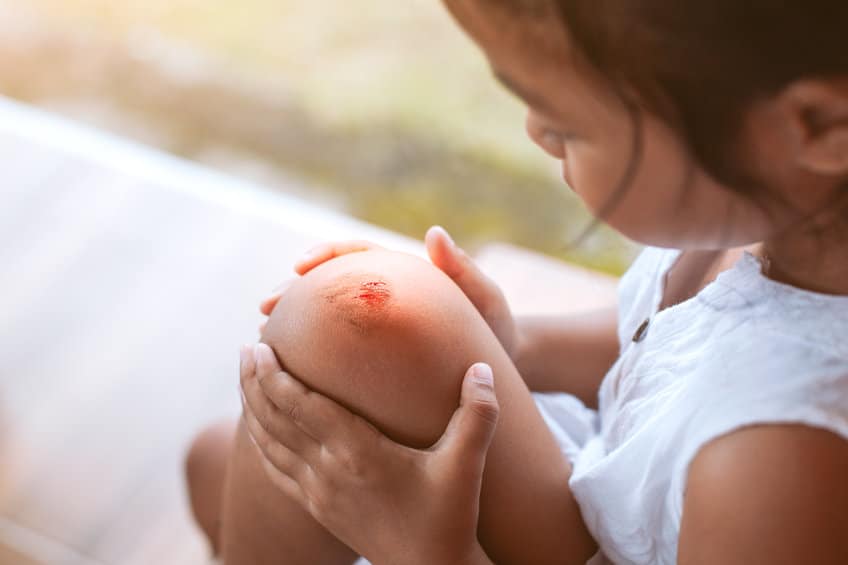Scars and Stretch Marks
Scars and Stretch Marks


Scars and stretch marks are some of the most commonly occurring skin-related concerns facing people around the world.
Back to top
Understanding scars and stretch marks
In the developed world, 100 million people acquire new scars annually. Whilst global figures are unknown, they are undoubtedly much higher.1 In some instances, scars can cause physical discomfort, including pain, itchiness and tenderness. This is particularly relevant if the scar occurs across a joint, where it can limit mobility. Stretch marks (striae) are also a type of scar, however, most people view them differently to scars. In addition to physical discomfort, scars can cause distressing psychological effects. In an image-conscious society that places large importance on how we look, scars that are aesthetically unpleasant can affect an individual’s confidence and cause low self-esteem. These psychological effects often vary depending on the location of the scar, how it occurred, as well as the age and sex of the scar sufferer.2
Back to top
WHAT IS A SCAR?
A scar forms as part of the natural healing process following an injury. When the dermis - the second layer of skin - is damaged, the body forms collagen fibers to repair the damage, and that can eventually result in the formation of a scar. Because our bodies are designed to repair scars quickly and not perfectly, we are often left with unsightly scars, which can cause people physical discomfort and to feel self-conscious. The final appearance of a scar will vary from person to person and depends on several factors. The shape, size, and depth of the wound contribute to the way a scar forms, as does the amount of blood that can get to the area, skin type, the age of the person and even nutritional status will play a role in determining what a scar will look like.3
Back to top
What are stretch marks?
Stretch marks occur during periods of rapid changes in weight (e.g. teenage growth spurts, pregnancy) when the body expands faster than the skin covering it, causing internal tears in the skin tissue. When these tears repair themselves they form scars that are known as stretch marks.4 Although stretch marks do not represent a significant medical problem, they can cause emotional distress to those who develop them. The likelihood of developing stretch marks varies according to skin type, age, BMI, positive family history, diet and the hydration of the skin. As stretch marks heal, they go through a number of different stages, with older stretch marks being far harder to treat. Initially they are red in colour, can feel itchy and the surrounding skin appears flattened and thin. As time passes the stretch marks begin to darken, enlarge and lengthen. Once the stretch marks have matured and when the skin is no longer under tension they will start to fade and become paler. They may also appear slightly depressed and irregular in shape or length.
Back to top
Treatment of scars and stretch marks
Scars are unfortunately for life. No product exists that can make them disappear completely. There are, however, a number of treatments available that can help improve a scar’s appearance.5 
- Surgical revision and laser therapy - Surgical revision requires removing or remodelling problem scars through surgery, while laser therapy involves using cosmetic laser to resurface problem scars. Both of these options can yield significantly beneficial results yet remain inaccessible to most individuals because they are complex medical procedures that are relatively expensive.
- Injectable substances - Collagen and other soft tissue fillers are used to elevate sunken scars, while steroid injections can flatten and soften raised scars
- Cryotherapy - This method freezes the upper layer of the scar to remove the excess skin tissue.
- Radiotherapy - In severe cases low-dose, superficial radiation therapy is used to prevent the recurrence of keloid and hypertrophic scarring, post-surgery. This method of scar treatment is only used in extreme cases due to the risk of long-term side effects.
- Dermabrasion - This method involves controlled surgical scraping to remove the top layers of the skin.
- Chemical peels - This method, which uses chemicals to destroy the surface layer of the skin in a controlled way, can be effective for small or superficial scars.
- Silicone dressings - Silicone sheets or gels are used to prevent and treat hypertrophic scarring.
- Pressure bandages - These wound dressings are most often used for burn scars and can flatten and soften scars
- Topical gels, creams ointments and oils - The most cost-effective and least invasive means of improving the appearance of scars.

BUY NOW
Date reviewed: 03 December 2024Medical References
- A. Bayat, D. A. McGrouther, and M. W. J. Ferguson, “Skin scarring,” Br. Med. J., vol. 326, no. 7380, pp. 88–92, 2003.
- B. C. Brown, S. P. McKenna, K. Siddhi, D. A. McGrouther, and A. Bayat, “The hidden cost of skin scars: Quality of life after skin scarring,” J. Plast. Reconstr. Aesthetic Surg., vol. 61, no. 9, pp. 1049–1058, 2008.
- A. Bayat, D. A. McGrouther, and M. W. J. Ferguson, “Skin scarring,” Br. Med. J., vol. 326, no. 7380, pp. 88–92, 2003.
- M. L. Elsaie, L. S. Baumann, and L. T. Elsaaiee, “Striae distensae (Stretch Marks) and different modalities of therapy: An update,” Dermatologic Surg., vol. 35, no. 4, pp. 563–573, 2009.
- M. L. Elsaie, L. S. Baumann, and L. T. Elsaaiee, “Striae distensae (Stretch Marks) and different modalities of therapy: An update,” Dermatologic Surg., vol. 35, no. 4, pp. 563–573, 2009; T. A. Mustoe et al., “International clinical recommendations on scar management,” Plast. Reconstr. Surg., vol. 111, 2, pp. 560–571, 2002; S. Monstrey et al., “Updated scar management practical guidelines: Non-invasive and invasive measures,” J. Plast. Reconstr. Aesthetic Surg., vol. 67, no. 8, pp. 1017–1025, 2014; A. Hague and A. Bayat, “Therapeutic targets in the management of striae distensae: A systematic review,” J. Am. Acad. Dermatol., vol. 77, no. 3, pp. 559–568, 2017; H. Osman, N. Rubeiz, H. Tamim, and A. H. Nassar, “Risk factors for the development of striae gravidarum,” Am. J. Obstet. Gynecol., vol. 196, no. 1, pp. 62.e1-62.e5, 2007; S. Al-Himdani, S. Ud-Din, S. Gilmore, and A. Bayat, “Striae distensae: A comprehensive review and evidence-based evaluation of prophylaxis and treatment,” Br. J. Dermatol., vol. 170, no. 3, pp. 527–547, 2014.
November 8, 2022
Content Disclaimer:
You understand and acknowledge that all users of the Dis-Chem website or app are responsible for their own medical care, treatment, and oversight. All of the content provided on the website, are for INFORMATIONAL PURPOSES ONLY and DOES NOT CONSTITUTE THE PROVIDING OF MEDICAL ADVICE and is not intended to be a substitute for independent professional medical judgment, advice, diagnosis, or treatment. The content is not intended to establish a standard of care to be followed by a user of the website. You understand and acknowledge that you should always seek the advice of your physician or other qualified health provider with any questions or concerns you may have regarding your health. You also understand and acknowledge that you should never disregard or delay seeking medical advice relating to treatment or standard of care because of information contained in or transmitted through the website. Medical information changes constantly. Therefore the information on this website or on the linked websites should not be considered current, complete or exhaustive, nor should you rely on such information to recommend a course of treatment for you or any other individual. Reliance on any information provided on this website or any linked websites is solely at your own risk.









